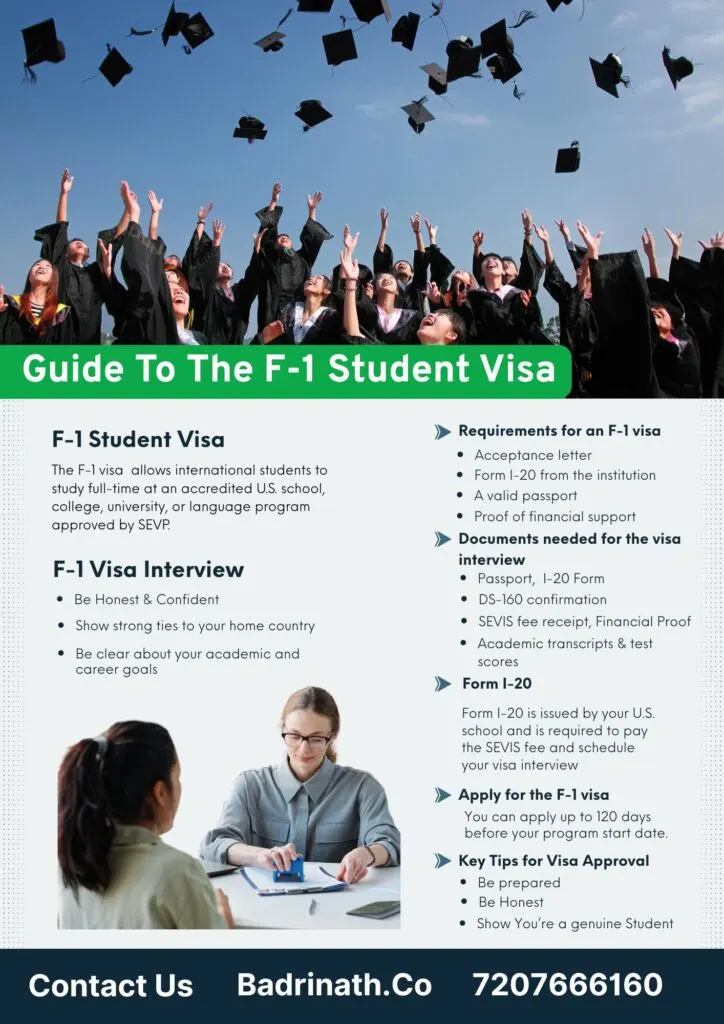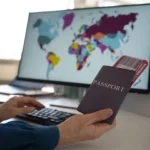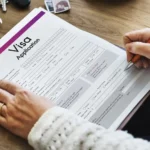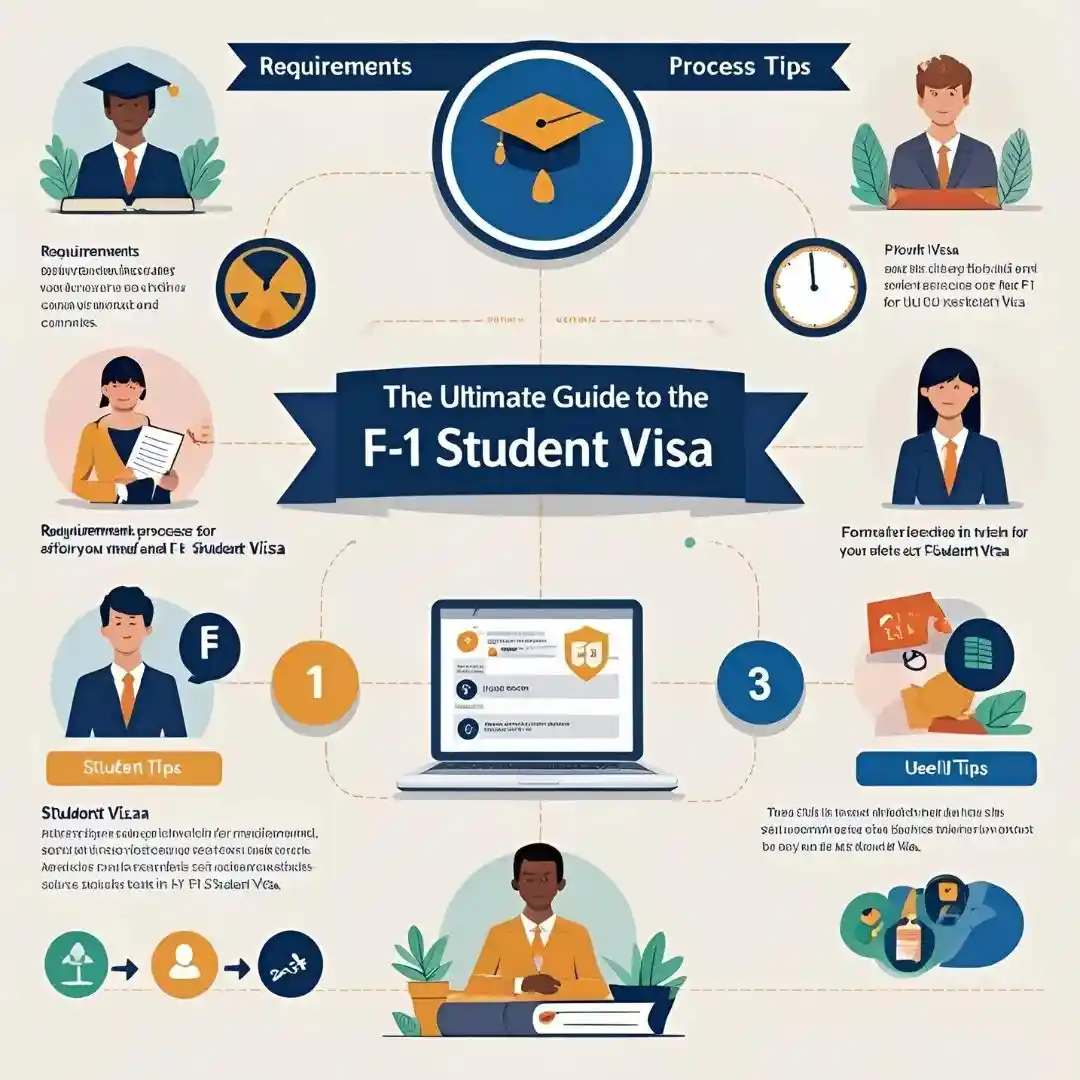What is an F-1 Student Visa?
The F-1 student visa is a non-immigrant visa. Additionally, it allows international students to pursue academic studies at accredited U.S. colleges, universities, seminaries, conservatories, academic high schools, elementary schools, and other academic institutions or language training programs.

Basic Eligibility Requirements
Academic Requirements
- Firstly, must be enrolled in an academic program leading to a degree, diploma, or certificate
- Additionally, the school must be approved by the Student and Exchange Visitor Program (SEVP)
- Furthermore, must be enrolled as a full-time student (except in specific circumstances)
Financial Requirements
- Basically, prove sufficient financial resources to cover tuition, living expenses, and other costs
- Furthermore, financial support can come from personal funds, family, scholarships, or approved sponsors
- Above all, must not intend to work illegally in the U.S.
Intent and Ties to Home Country
- Evidently, must demonstrate intent to return to home country after studies
- In addition, Show strong ties to home country (family, property, job prospects)
- Finally, prove the visit is temporary
Required Documents
Primary Documents
- Firstly, Form I-20 – Certificate of Eligibility issued by your school
- Additionally, Valid passport – Must be valid for at least 6 months beyond intended stay
- Also, DS-160 form – Online non-immigrant visa application
- Moreover, Visa application fee receipt – Currently $185 (subject to change)
- Furthermore, SEVIS I-901 fee receipt – Currently $350 (subject to change)
- Lastly, Passport-style photograph – Meeting specific requirements
Financial Documentation
- For example, Bank statements showing sufficient funds
- Besides, Scholarship or sponsorship letters
- Affidavit of Support (Form I-134) if applicable
- Additionally, Tax returns or income statements of sponsors
- Also, Property deeds or investment statements
Academic Documentation
- As can be seen, transcripts from previous schools
- Equally important, Standardized test scores (SAT, ACT, GRE, GMAT, etc.)
- Furthermore, English proficiency test scores (TOEFL, IELTS, etc.)
- Moreover, Letters of recommendation
- Finally, Statement of purpose or personal essay
Step-by-Step Application Process
1. Get Accepted to a SEVP-Approved School
- Apply and receive acceptance to an accredited U.S. institution
- School will issue Form I-20 after verifying your eligibility
- Pay SEVIS I-901 fee online at fmjfee.com
2. Complete the DS-160 Form
- Fill out the online application at ceac.state.gov
- Upload a digital photograph meeting requirements
- Print confirmation page with barcode
3. Pay Visa Application Fee
- Pay the $185 visa application fee
- Payment methods vary by country
- Keep receipt for visa interview
4. Schedule Visa Interview
- Contact U.S. embassy or consulate in your country
- Schedule appointment online or by phone
- Interview wait times vary by location and season
5. Attend Visa Interview
- Arrive early with all required documents
- Be prepared to answer questions about your studies and intentions
- Provide biometric information (fingerprints)
6. Visa Processing and Decision
- Processing times vary (typically 3-5 business days)
- If approved, passport will be returned with visa
- If denied, you’ll receive explanation and potential next steps
Common Interview Questions
- Why did you choose this particular school and program?
- How will you finance your education?
- What are your plans after graduation?
- Why didn’t you choose to study in your home country?
- Do you have family or friends in the United States?
- What ties do you have to your home country?
Understanding Your F-1 Status
Duration of Stay
- Authorized for “Duration of Status” (D/S)
- Can stay as long as maintaining valid F-1 status
- Must complete program by I-20 end date
- 60-day grace period after program completion
Maintaining Status Requirements
- Maintain full-time enrolment (minimum 12 credit hours)
- Make normal progress toward degree
- Keep passport and I-20 valid
- Report address changes within 10 days
- Don’t work without authorization
Important Deadlines and Timelines
Application Timeline
- Apply for schools 6-12 months before the intended start
- Apply for a visa 3-4 months before the program start
- Cannot enter the U.S. more than 30 days before the program start
- Must arrive by I-20 program start date
Renewal and Extension
- I-20 must be kept current throughout the stay
- Apply for program extension before the current I-20 expires
- Transfer between schools requires an updated I-20
- Reinstatement is available for certain status violations

Conclusion
Remember that immigration law can be complex and subject to change. Always consult official government sources and consider professional legal advice for your specific situation. The F-1 visa opens doors to world-class education in the United States, and proper preparation significantly increases your chances of success.
Read More About the Topic
External Links
F-1 Visa for International Students: Requirements, Rules, Status
F1 Student Visa: The Complete Guide for International Students
Internal Links
Top 15 F-1 Visa Interview Questions and Expert Answers
“How to Get Strong Letters of Recommendation for US University Applications”







